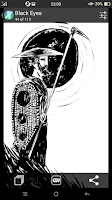Descender Vol. 3: Singularities by Jeff Lemire & Dusting Nguyen (2016)
, 08 April 2018
I wasn't sure whether to buy this volume due to the many non-enthusiastic reviews I've seen around, but I'm glad I did. I found some of the events and characters in the previous two volumes a bit unpolished, not well profiled, superficial, a bit silly, but once I read this volume, they all make sense. This is a flashback in time for each of the main characters, in separate chapters, and also a multi-time flashback for each of them, so we get to see and know from where they are coming from. To me that's was the right thing to do to give the story soul and psychological depth. Even the annoying Driller the Killer makes sense once we read the chapter devoted to it in this book. As a stand-alone volume might not be worth buying, but if you are reading or intend to read the whole series, this is a must.
I am always mesmerised by Nguyen masterly drawing and water-colouring. It is a total delight to see each of his vignettes, no matter what he's painting, faces, landscapes, outaspaces, details, anything. I resented, though, some of the imagery, which was too familiar and associable with characters I've seen in the old Star Wars and Totall Recall movies.
I love the lettering used in this series. Very creative and audible, if that can be said.
The Kindle rendering of the book is excellent, with awesome quality details. Double tapping individuate vignettes and allows us to swipe between them effortlessly; however, some of them do not automatically seize to the preferable reading size when there are vignettes with small lettering, but pitching out each vignette solves the problem.
Overall, very enjoyable, and I loved the story between Effie and Andy. Also, very short and a bit pricey.
I am always mesmerised by Nguyen masterly drawing and water-colouring. It is a total delight to see each of his vignettes, no matter what he's painting, faces, landscapes, outaspaces, details, anything. I resented, though, some of the imagery, which was too familiar and associable with characters I've seen in the old Star Wars and Totall Recall movies.
I love the lettering used in this series. Very creative and audible, if that can be said.
The Kindle rendering of the book is excellent, with awesome quality details. Double tapping individuate vignettes and allows us to swipe between them effortlessly; however, some of them do not automatically seize to the preferable reading size when there are vignettes with small lettering, but pitching out each vignette solves the problem.
Overall, very enjoyable, and I loved the story between Effie and Andy. Also, very short and a bit pricey.














































